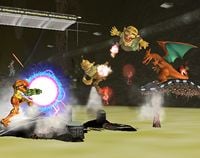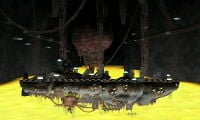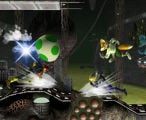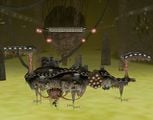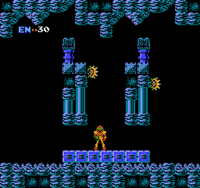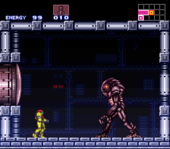Brinstar
| Brinstar | |
|---|---|
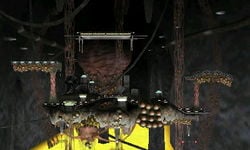 File:MetroidSymbol(preBrawl).png | |
| Universe | Metroid |
| Appears in | Melee Brawl SSB4 (3DS) |
| Availability | Starter in Melee Starter in Brawl Starter in for 3DS |
| Crate type | Futuristic (Brawl and Smash 4) |
| Tracks available | In Melee: Brinstar Brinstar Depths (Alternate in Adventure mode) In Brawl: Brinstar (Melee) Brinstar Depths (Melee) Bolded track must be unlocked In SSB4: Brinstar Brinstar Depths (Alternate) |
| Article on Metroid Wiki | Brinstar |
Brinstar (ブリンスタ, Brinstar) is the default Metroid stage that appears in Super Smash Bros. Melee, Super Smash Bros. Brawl, and Super Smash Bros. for Nintendo 3DS. This stage is based after the first area of Planet Zebes from the original Metroid. It is essentially a redesign of Planet Zebes from the original Super Smash Bros..
Stage layout
The stage consists of a main, rocky platform, two soft platforms on the side and a hovering metallic soft platform in the center. The main platform can be passed through from below, and it actually consists of two parts held together by a fleshy blob on the right side: said blob can be weakened by attacks, and when destroyed the main platform gets separated. The same can happen to the fleshy poles which keep the main platform and the side ones together: when they are destroyed, the platforms that were being supported tilt at a very sharp angle.
The destroyable parts will start to regenerate if they are not continuously attacked, fully growing back after a while. While regenerating, the substance that holds the stage together is fall-through.
Occasionally, an earthquake occurs and acid starts to rise. The acid deals damage and heavy knockback on touch, though it can prevent characters from being KOed on the bottom. It covers most of the stage, leaving out only the topmost platform and, if their supports are destroyed, the top parts of the side platforms. After a while, the acid subsides.
In the back of the main platforms there are some ruins and a lone Chozo statue, which occasionally gets up and walks around with no gameplay effect. The background is occupied by a large pool of acid with an unindentified fleshy being rising from it.
Brinstar is considered the best Jigglypuff and Ganondorf stage in Melee (due to rest combos and forward aerial combos with Ganon off the lava) and one of the better Mr. Game & Watch and Wario stages in Brawl (due to air camping beneath the platform).
Ω mode
Tournament legality
This stage used to be a counterpick stage because many did not see the acid as a major problem, and instead focused on its strange, but relatively non-obtrusive stage design. However, it was later banned in Melee and deemed more of a banned stage than a counterpick stage in Brawl, not making the stage list in major tournaments such as Apex 2012 despite the Unity Ruleset proclaiming it as a counterpick. This stage is still banned because many players agree that it gives monopolizing advantages to certain groups of characters. The acid reduces the stage to a very small size, forcing characters to stay in the air and giving unfair advantages to characters with good aerial games; characters with good meteor smashes or spikes also dominate as they can repeatedly rack up damage by thrusting unfortunate opponents into the acid, which knocks them back up to repeat the process.
Gallery
Origin
Brinstar is the first level that the player has to venture through in original Metroid. In Metroid's Brinstar there are some rooms which feature yellow acid on the ground. If the player goes in the acid it does some damage. Towards the end of Super Metroid, in Mother Brain's room an earthquake occurs and acid starts rising up. While the acid in this stage originated in Metroid, the acid going up and down after an earthquake could be a reference to either Metroid II or Super Metroid (perhaps more likely Super Metroid as Metroid II is set on planet SR388 while Super Metroid is set on Planet Zebes, which is where Brinstar is located).
In Metroid there are secret paths that the player has to take. The secret paths usually involve laying down bombs and exploding certain blocks that led to a new area. In this stage there is this organic material that can be broken up which could likely be a reference to those destructible blocks. Mother Brain's room in both Metroid and Super Metroid feature these things called "Zebetites" which are the life veins for Mother Brain. The player has to shoot them with missiles to destroy them. As the player shoots the veins get thinner and thinner. If the player thins it out and doesn't keep shooting they start to grow back. In this stage two similar veins can be seen. They also retain how the vein can be thinned out and be broken, but in both Metroid games when the veins break they stay broken. This stage has the vein growing back after it has been broken.
Metroid has the player collecting items through the hands of Chozo statues. Super Metroid has kept these Chozo statues except some of them come to life and proceeds to attack the player; these hostile versions are known as Torizos. There are also a few Chozo statues that carry the player across areas that the player wouldn't be able to get to. In the background of this stage, there is a Chozo statue which sits in the same fashion as seen in both Metroid and Super Metroid. There are times when this Chozo statue comes to life and walks across the stage. This is probably a reference to the different types of Chozo statues that come to life in Super Metroid.
In the three Metroid games released at the time of Melee, the player is pretty much always traversing through the caves of planets. This entire stage is featured inside a giant cave. The final boss of Metroid is Mother Brain. As the player shoots her, parts of her pulsate. Mother Brain is also featured in Super Metroid, but she doesn't act in the same manner. In the far background of this stage is a pulsating being which shares some properties with Mother Brain. Out of all the rooms of Brinstar in both Metroid and Super Metroid not one looks similar to the overall design of this stage.
Trivia
- There are several references to Mother Brain in this stage. The fleshy stalks that connect the platforms have some characteristics of the 'Zebetites' (life veins of Mother Brain) that Samus had to break before reaching the final boss in Metroid and Super Metroid. Also, the gigantic alien organism in the far background somewhat resembles Mother Brain itself. While the organism lacks several of Mother Brain's characteristics, such as her recognizable single eye, a hacked camera reveals in profile that it is actually a giant brain complete with a spinal cord (which appears to be a "tentacle" otherwise).
- Hacked cameras also reveal that the stage is actually an extremely large tunnel which strongly resembles the one from Mother Brain's appearance in Metroid. The far back of the tunnel makes a very sharp left, presumably to form a "back" of the tunnel for the sake of the game's appearance.
- It is possible to perform the earthquake glitch here.
- In Brawl during Training Mode, the rise and fall of the acid and the regeneration of the organic parts are not affected by the player's choice of speed.
- This is the only Melee stage in SSB4 to not have a new remix.
- If Master Hand or Crazy Hand dies in Stamina, they will bounce off of the acid.
External links
| Stages in Super Smash Bros. Melee | |
|---|---|
| Starter stages | Brinstar · Corneria · Fountain of Dreams · Great Bay · Green Greens · Icicle Mountain · Jungle Japes · Kongo Jungle · Mushroom Kingdom · Mute City · Onett · Pokémon Stadium · Princess Peach's Castle · Rainbow Cruise · Temple · Venom · Yoshi's Island · Yoshi's Story |
| Unlockable stages | Battlefield · Big Blue · Brinstar Depths · Final Destination · Flat Zone · Fourside · Mushroom Kingdom II · Poké Floats |
| Dream Land · Kongo Jungle · Yoshi's Island | |
|
| |
|---|---|
| Fighters | Samus (SSB · SSBM · SSBB · SSB4 · SSBU) · Zero Suit Samus (SSBB · SSB4 · SSBU) · Ridley (SSBU) · Dark Samus (SSBU) |
| Assist Trophies | Metroid · Dark Samus · Mother Brain |
| Bosses | Ridley · Meta Ridley |
| Stages | Planet Zebes · Brinstar · Brinstar Depths · Frigate Orpheon · Norfair · Pyrosphere Brinstar Escape Shaft (Adventure Mode) |
| Item | Screw Attack · Power Suit Piece |
| Enemies | Geemer · Kihunter · Metroid · Reo · FG II-Graham · Joulion · Zero |
| Other | Gunship · Kraid |
| Trophies, Stickers and Spirits | Trophies (SSBM · SSBB · SSB4) · Stickers · Spirits |
| Music | Brawl · SSB4 · Ultimate |
| Masterpieces | Metroid · Super Metroid |
